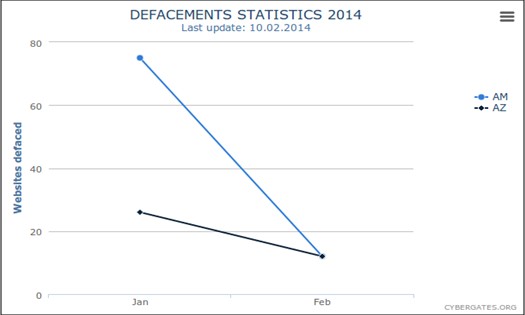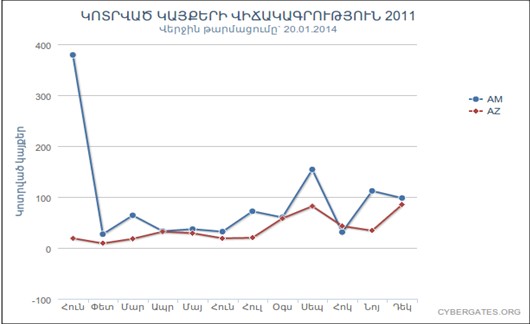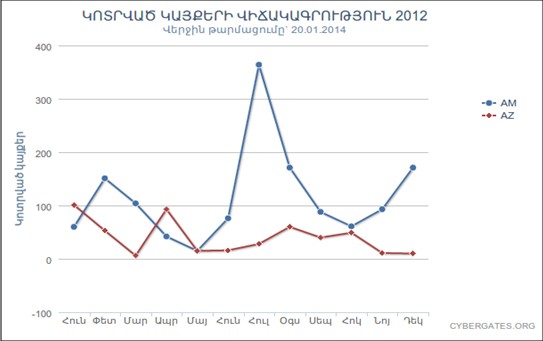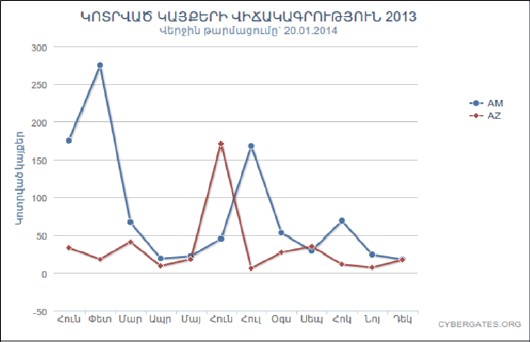 03.03.2014
03.03.2014HACKER ACTIVITY BETWEEN ARMENIA AND AZERBAIJAN
Samvel Martirosyan
Expert, Center of Information Studies, Noravank Foundation
In January 2014 a number of hacker attacks on Armenian and Azerbaijani websites took place. On one hand, it was a part of the series of attacks traditionally launched every January, and on the other hand it was different in terms of some qualitative and quantitative changes. It is obvious that new hacker groups are formed in Armenia, which act only against the Azerbaijani sector of the internet.
Every year, on January 20 Azeri hacker groups carry out attacks on Armenian sites. This is done in commemoration of Baku events on January 20, 1990, during which the clashes between Soviet Army and combatants of the Azerbaijani Popular Front resulted in deaths of dozens of people, including innocent bystanders (these clashes followed the massacre of Armenians in Baku on January 13-19, 1990 1).
The mass attack of Azerbaijani hackers on Armenian sites2 on January 20 opened up the 2014 new season of Armenian-Azerbaijani hacker war. In 2014 (January and first 10 days of February) total 85 Armenian sites were hacked. In response, the Armenians hacked 40 Azerbaijani sites (see Figure 1). About 10% of the hacked sites were targeted by hackers from foreign countries.

Figure 1. Statistics of Cybergates.org on the number of hacked/defaced sites in .am and .az domains in the period of January and first 10 days of February, 2014
It has to be noted that as far as the attack targets are concerned, Azerbaijani government sites are hacked time to time. As for the Armenian segment, the situation is somewhat ambiguous. On one hand, since autumn 2009, when the government sites of the Republic of Armenia went under protection of the National Security Service, there has been no successful attack on them. On the other hand, government sites of the Nagorno Karabakh Republic come under attack several times in any year. For example, on January 20, 2014, five NKR government sites were attacked by Azerbaijani hackers3.
Yearly statistics (see Figures 2 to 4, where .az sites are denoted in red, and .am sites in blue) show that by 2013 the situation with the Armenian sites has improved, whereas with the Azerbaijani sites it has worsened, which can be explained by the fact that Armenian hacker groups are stepping up their activities.
In 2012-2013 some rather serious changes actually occurred in the hacker communities. In Azerbaijan the hacker groups acting against Armenia and Armenians merged and formed the largest Azerbaijani hacker group called Antiarmenia. The increased activity of Azerbaijani hackers prompted Armenian hackers to form new groups that target both Azerbaijani and Turkish sites. While in 2010-2011 there were just two-three few small hacker groups in Armenia, in 2013-2014 about 10 groups emerged. Among those, to mention a few, are: Armenian Cyber Army, Ananun, A.S.A.L.A, Monte Melkonian Cyber Army, Armenian Rabiz Army.
As a matter of fact, mutual hacking attacks led to a sporadic emergence of hacker communities, which may be used in future to create formal cyber-armies in both countries.

Figure 2. Statistics provided by Cybergates.org on the number of hacked/defaced sites in .am and .az domains in 2011.

Figure 3. Statistics provided by Cybergates.org on the number of hacked/defaced sites in .am and .az domains in 2012.

Figure 4. Statistics provided by Cybergates.org on the number of hacked/defaced sites in .am and .az domains in 2013.
1 Massacres of Armenians in 1990 http://baku.am/top-content-3
2 List of the hacked Armenian sites during the Azerbaijani “black January” attack, http://www.banman.am/2014/01/azerbaijan-hack-armenian-sites.html
3 The list of the five NKR government sites hacked by Azerbaijanis on January 20, 2014 is as follows: jraberd.nk.am , edu.nkr.am, mud.nkr.am, sport.nkr.am , police.nkr.am
Return
Another materials of author
- MEDIA CONFRONTATION BETWEEN ARMENIAN AND AZERBAIJANI FORCES[08.04.2016]
- SAMVEL MARTIROSYAN: WHY AZERBAIJANI MEDIA STAYED SILENT[06.04.2016]
- SOCIAL MEDIA IN ARMENIA (2015 data)[10.07.2015]
- TELECOMMUNICATIONS INDUSTRY OF ARMENIA IN 2014 [15.05.2015]
- POTENTIAL MODELS OF INTERNET GOVERNANCE AND ARMENIA’S APPROACHES[27.04.2015]
- PROPOSALS REGARDING CYBERSECURITY OF ARMENIA[30.10.2014]
- DDOS ATTACKS ON ARMENIA CAUSE CONCERNS[12.05.2014]
- SNOWDEN’S DISCLOSURE: WORLD UNDER THE AMERICAN AND BRITISH SURVEILLANCE[03.12.2013]
- PENETRATION OF INTERNET INTO THE SOUTH CAUCASUS[04.10.2013]
- DATA PROTECTION ISSUES IN ARMENIA[25.03.2013]


